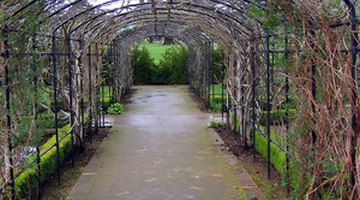How to Build a Garden Arbor Out of Conduit
A garden arbor showcases climbing plants and provides a focal point for your garden or pathway. The shape and material used can vary dramatically. One arbor may be arched wrought iron and include a gate. Another might designate a garden room with an open-air, cedar beam roof.

Local hardware stores sell these support structures for $200 or more. When you want to invest more in plants than hardscaping, electrical conduit makes an affordable garden arbor choice.
-
Sketch out your plan. Include dimensions for how wide and deep you want your arbor.
-
Choose your site. Measure the space based on the dimensions in your plan. Mark corner support positions with spray paint.
-
Drive concrete reinforcing bar, also called rebar, into the ground until it’s about half buried, keeping it as straight and level as possible.
-
Cut conduit for the horizontal support to the planned width of your arbor. Attach one corner coupling to the top of each 10-foot vertical leg and connect them with your horizontal support to complete the front side of the arbor. Repeat for the back side. Position corner couplings so all open joints face the opposite side.
-
Cut two pieces of conduit to the arbor’s desired depth. Attach the front and back faces using these vertical segments. Secure nylon netting along sides and top of arbor.
-
Slide the vertical legs of arbor over rebar posts. Plant your climbing perennials or vegetables according to packaging.
Things You Will Need
- Spray paint for marking ground
- Pipe cutter
- 4 cube corner couplings
- 8 10-foot segments of thin-walled electrical conduit
- 4 2-foot, ½-inch diameter stakes of concrete reinforcing bar (rebar)
- Nylon netting
- Level
- Sledge hammer
- Drill
- Tape measure
Tip
For an arched arbor, use a pipe bender to create lateral supports. Practice on a scrap piece of conduit. This tool can take some finesse. If you aren’t happy with the exposed metal appearance of the conduit, apply a few coats of metal-adhesive spray paint. Garden arbors aren’t just for roses or grape vines. Try training vegetables on your arbor for a change of pace. Pole beans, tomatoes, pumpkins and watermelons are all great climbers.
Warning
Contact your utility companies to check for underground obstacles such as electric, gas or water lines near your garden arbor site.
Don’t attempt to pound conduit directly into the ground. It isn’t as strong as the rebar and will bend easily.
References
- “All New Square Foot Gardening: Grow More in Less Space”; Mel Barholomew; 2006
Writer Bio
Chris Summers is a professional freelance writer/editor with more than 10 years of experience in the field of health and wellness. She has also developed more than 20 titles for Frommer's Travel Guides. Her other works have appeared in print and web publications, including ICON Magazine and The Indianapolis Star.
Photo Credits
- rose garden in winter image by green308 from Fotolia.com
- rose garden in winter image by green308 from Fotolia.com
More Articles



